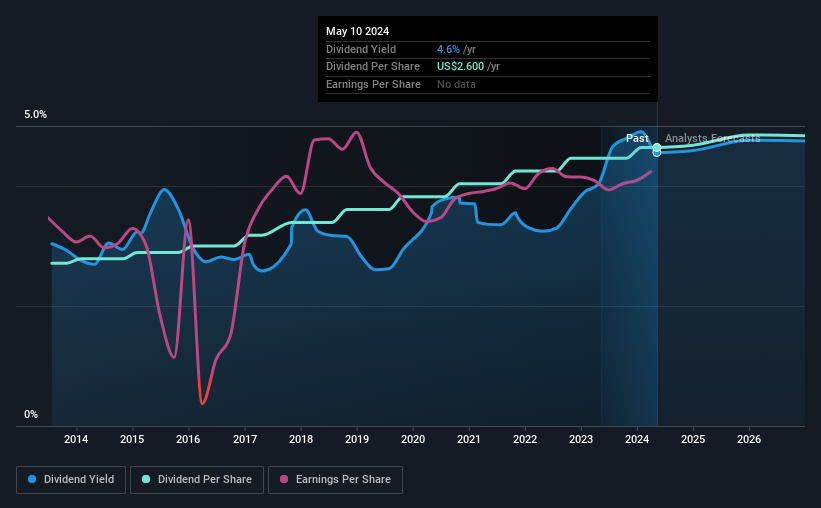We Wouldn't Be Too Quick To Buy Black Hills Corporation (NYSE:BKH) Before It Goes Ex-Dividend
Regular readers will know that we love our dividends at Simply Wall St, which is why it's exciting to see Black Hills Corporation (NYSE:BKH) is about to trade ex-dividend in the next four days. The ex-dividend date is one business day before the record date, which is the cut-off date for shareholders to be present on the company's books to be eligible for a dividend payment. The ex-dividend date is of consequence because whenever a stock is bought or sold, the trade takes at least two business day to settle. Meaning, you will need to purchase Black Hills' shares before the 16th of May to receive the dividend, which will be paid on the 1st of June.
The company's upcoming dividend is US$0.65 a share, following on from the last 12 months, when the company distributed a total of US$2.60 per share to shareholders. Last year's total dividend payments show that Black Hills has a trailing yield of 4.6% on the current share price of US$57.05. If you buy this business for its dividend, you should have an idea of whether Black Hills's dividend is reliable and sustainable. So we need to investigate whether Black Hills can afford its dividend, and if the dividend could grow.
View our latest analysis for Black Hills
Dividends are typically paid from company earnings. If a company pays more in dividends than it earned in profit, then the dividend could be unsustainable. Black Hills paid out 62% of its earnings to investors last year, a normal payout level for most businesses. Yet cash flows are even more important than profits for assessing a dividend, so we need to see if the company generated enough cash to pay its distribution. It paid out more than half (72%) of its free cash flow in the past year, which is within an average range for most companies.
It's positive to see that Black Hills's dividend is covered by both profits and cash flow, since this is generally a sign that the dividend is sustainable, and a lower payout ratio usually suggests a greater margin of safety before the dividend gets cut.
Click here to see the company's payout ratio, plus analyst estimates of its future dividends.
Have Earnings And Dividends Been Growing?
Businesses with shrinking earnings are tricky from a dividend perspective. If earnings decline and the company is forced to cut its dividend, investors could watch the value of their investment go up in smoke. So we're not too excited that Black Hills's earnings are down 3.9% a year over the past five years.
Many investors will assess a company's dividend performance by evaluating how much the dividend payments have changed over time. Since the start of our data, 10 years ago, Black Hills has lifted its dividend by approximately 5.5% a year on average. That's interesting, but the combination of a growing dividend despite declining earnings can typically only be achieved by paying out more of the company's profits. This can be valuable for shareholders, but it can't go on forever.
To Sum It Up
Is Black Hills an attractive dividend stock, or better left on the shelf? It's never good to see earnings per share shrinking, but at least the dividend payout ratios appear reasonable. We're aware though that if earnings continue to decline, the dividend could be at risk. Bottom line: Black Hills has some unfortunate characteristics that we think could lead to sub-optimal outcomes for dividend investors.
Although, if you're still interested in Black Hills and want to know more, you'll find it very useful to know what risks this stock faces. Be aware that Black Hills is showing 2 warning signs in our investment analysis, and 1 of those is potentially serious...
Generally, we wouldn't recommend just buying the first dividend stock you see. Here's a curated list of interesting stocks that are strong dividend payers.
Have feedback on this article? Concerned about the content? Get in touch with us directly. Alternatively, email editorial-team (at) simplywallst.com.
This article by Simply Wall St is general in nature. We provide commentary based on historical data and analyst forecasts only using an unbiased methodology and our articles are not intended to be financial advice. It does not constitute a recommendation to buy or sell any stock, and does not take account of your objectives, or your financial situation. We aim to bring you long-term focused analysis driven by fundamental data. Note that our analysis may not factor in the latest price-sensitive company announcements or qualitative material. Simply Wall St has no position in any stocks mentioned.

